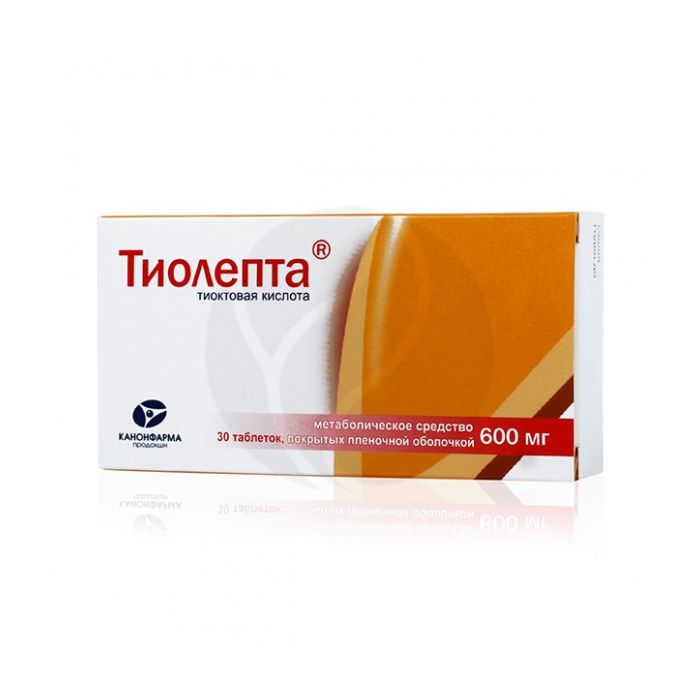Thiolepta tablets p / o 600mg, No. 30
Russian Pharmacy name:
Тиолепта таблетки п/о 600мг, №30
Diabetic and alcoholic polyneuropathy.
Assign inside 600 mg (2 tablets) 1 time per day. The tablets are taken on an empty stomach, approximately 30 minutes before the first meal, without chewing and with a small amount of liquid. The duration of the course of treatment is determined by the doctor.
1 tablet contains:
active substance: thioctic acid - 600 mg;
excipients: potato starch, aerosil A-300 (colloidal silicon dioxide), primellose (croscarmellose sodium), calcium stearate, milk sugar (lactose), microcrystalline cellulose, castor oil, select AQ-01812 (hydroxypropylmethylcellulose (hypromellose), polyethylene macrogol 400), polyethylene glycol 6000 (macrogol 6000), titanium dioxide, iron oxide yellow, quinoline yellow.
film sheath: Selecoat AQ-01812 (hypromellose - hydroxypropyl methylcellulose, macrogol - polyethylene glycol 400, macrogol 6000 - polyethylene glycol 6000, titanium dioxide, iron dye yellow oxide, quinoline yellow dye)
Hypersensitivity to the components of the drug.
Pregnancy, breastfeeding period (there is no sufficient experience with the drug).
Childhood (efficacy and safety of use have not been established).
Pharmacotherapeutic group : Metabolic agent.
Pharmacological properties
Thioctic acid (alpha-lipoic acid) is an endogenous antioxidant (binds free radicals), formed in the body by the oxidative decarboxylation of alpha-ketoxylot. As a coenzyme of mitochondrial multienzyme complexes, it participates in the oxidative decarboxylation of pyruvic acid and alpha-keto acids. Promotes a decrease in blood glucose and an increase in glycogen in the liver, as well as overcoming insulin resistance. By the nature of the biochemical action, it is close to the vitamins of group B. It participates in the regulation of lipid and carbohydrate metabolism, stimulates cholesterol metabolism, and improves liver function. It has a hepatoprotective, hypolipidemic, hypocholesterolemic, hypoglycemic effect.
Pharmacokinetics.
When taken orally, it is rapidly and completely absorbed from the gastrointestinal tract (intake with food reduces absorption). The time to reach maximum concentration is 40-60 minutes. Bioavailability - 30%.
Has a 'first pass' effect through the liver. The formation of metabolites occurs as a result of side chain oxidation and conjugation. The volume of distribution is about 450 ml / kg. Thioctic acid and its metabolites are excreted by the kidneys (80-90%). The half-life is 20-50 minutes. The total plasma clearance is 1015 ml / min.
Side effect
Usually ThioleptaЃ is well tolerated. Dyspepsia is possible, including nausea, vomiting, heartburn. In some cases, the development of allergic skin reactions (urticaria) is possible. Hypoglycemia may develop (due to improved glucose uptake).
Overdose
Symptoms: headache, nausea, vomiting.
Treatment: symptomatic. There is no specific antidote.
Interaction with other medicinal products
Thioctic acid reacts with ionic metal complexes (for example, with cisplatin), therefore, with the simultaneous use of ThioleptaЃ, it can reduce the effect of cisplatin. After taking the drug ThioleptaЃ in the morning, it is recommended to use iron and magnesium preparations, as well as to consume dairy products (due to the calcium content in them) in the afternoon or in the evening.
With the simultaneous use of ThioleptaЃ enhances the effect of insulin and oral hypoglycemic agents.
Alcohol (ethanol) reduces the therapeutic activity of thioctic acid.
special instructions
Patients taking ThioleptaЃ should refrain from drinking alcohol.
In patients with diabetes mellitus, constant monitoring of the concentration of glucose in the blood is necessary, especially at the initial stage of therapy. In some cases, it is necessary to reduce the dose of insulin or an oral hypoglycemic drug to avoid the development of hypoglycemia.

